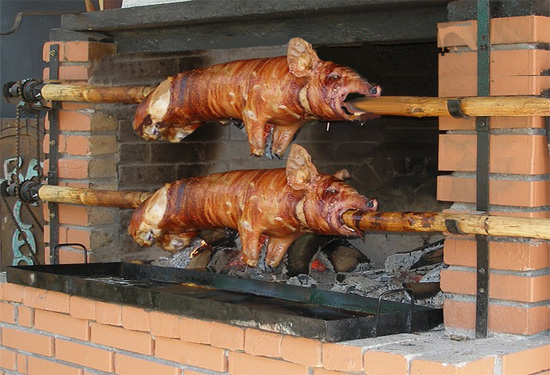|

Roast pig is sometimes partly divided before serving. Cut off the head and
divide it through the middle; then divide through the backbone. Place it
on the platter back to back, with half the head on each end of the dish.
If the pig is very young, it is in better style to serve it whole.
Before cooking, truss the forelegs forward and the hind legs backward.
Place the pig on the platter with the head at the left. Cut off the
head, separating the neck-joint with the point of the knife,
then cut through the flesh on either side. Take off the shoulders by cutting in a
circle from under the foreleg round nearly to the backbone and down
again. Bend it forward and cut through the joint. Cut off the hams in
the same way. Then split the backbone the entire length and divide
between each rib. Cut slices from the thickest part of the hams and the
shoulders.
The ribs are the choice portion, but those who like it at all
consider any part of it a delicacy.
"Of all the delicacies in the whole mundus edibiles, I
will maintain roast pig to be the most delicate. There is no flavor
comparable, I will contend, to that of the crisp, tawny, well-watched,
not over-roasted crackling, as it is well called—the very teeth are
invited to their share of the pleasure at this banquet in overcoming
the coy, brittle resistance—with the adhesive oleaginous—oh, call it
not fat! but an indefinable sweetness growing up to it—the tender
blossoming of fat—fat cropped in the bud—taken in the shoot—in the
first innocence—the cream and quintessence of the child-pig’s yet pure
food—the lean, no lean, but a kind of animal manna—or rather fat and
lean (if it must be so) so blended and running into each other that
both together make but one ambrosian result or common substance."
~ Charles Lamb.
|







